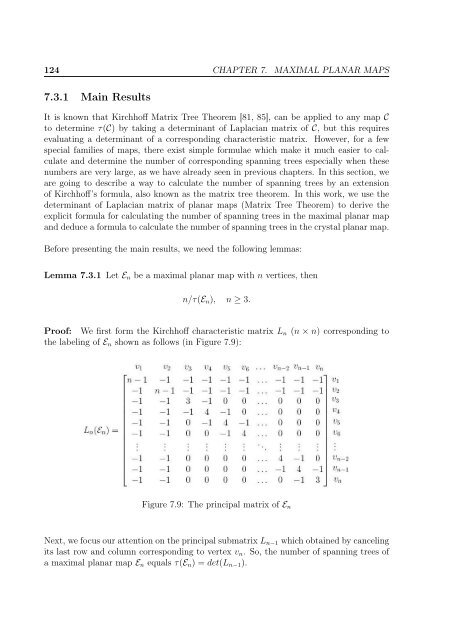enumeration of the number of spanning trees in some ... - Toubkal
enumeration of the number of spanning trees in some ... - Toubkal
enumeration of the number of spanning trees in some ... - Toubkal
Create successful ePaper yourself
Turn your PDF publications into a flip-book with our unique Google optimized e-Paper software.
124 CHAPTER 7. MAXIMAL PLANAR MAPS7.3.1 Ma<strong>in</strong> ResultsIt is known that Kirchh<strong>of</strong>f Matrix Tree Theorem [81, 85], can be applied to any map Cto determ<strong>in</strong>e τ(C) by tak<strong>in</strong>g a determ<strong>in</strong>ant <strong>of</strong> Laplacian matrix <strong>of</strong> C, but this requiresevaluat<strong>in</strong>g a determ<strong>in</strong>ant <strong>of</strong> a correspond<strong>in</strong>g characteristic matrix. However, for a fewspecial families <strong>of</strong> maps, <strong>the</strong>re exist simple formulae which make it much easier to calculateand determ<strong>in</strong>e <strong>the</strong> <strong>number</strong> <strong>of</strong> correspond<strong>in</strong>g <strong>spann<strong>in</strong>g</strong> <strong>trees</strong> especially when <strong>the</strong>se<strong>number</strong>s are very large, as we have already seen <strong>in</strong> previous chapters. In this section, weare go<strong>in</strong>g to describe a way to calculate <strong>the</strong> <strong>number</strong> <strong>of</strong> <strong>spann<strong>in</strong>g</strong> <strong>trees</strong> by an extension<strong>of</strong> Kirchh<strong>of</strong>f’s formula, also known as <strong>the</strong> matrix tree <strong>the</strong>orem. In this work, we use <strong>the</strong>determ<strong>in</strong>ant <strong>of</strong> Laplacian matrix <strong>of</strong> planar maps (Matrix Tree Theorem) to derive <strong>the</strong>explicit formula for calculat<strong>in</strong>g <strong>the</strong> <strong>number</strong> <strong>of</strong> <strong>spann<strong>in</strong>g</strong> <strong>trees</strong> <strong>in</strong> <strong>the</strong> maximal planar mapand deduce a formula to calculate <strong>the</strong> <strong>number</strong> <strong>of</strong> <strong>spann<strong>in</strong>g</strong> <strong>trees</strong> <strong>in</strong> <strong>the</strong> crystal planar map.Before present<strong>in</strong>g <strong>the</strong> ma<strong>in</strong> results, we need <strong>the</strong> follow<strong>in</strong>g lemmas:Lemma 7.3.1 Let E n be a maximal planar map with n vertices, <strong>the</strong>nn/τ(E n ), n ≥ 3.Pro<strong>of</strong>: We first form <strong>the</strong> Kirchh<strong>of</strong>f characteristic matrix L n (n × n) correspond<strong>in</strong>g to<strong>the</strong> label<strong>in</strong>g <strong>of</strong> E n shown as follows (<strong>in</strong> Figure 7.9):Figure 7.9: The pr<strong>in</strong>cipal matrix <strong>of</strong> E nNext, we focus our attention on <strong>the</strong> pr<strong>in</strong>cipal submatrix L n−1 which obta<strong>in</strong>ed by cancel<strong>in</strong>gits last row and column correspond<strong>in</strong>g to vertex v n . So, <strong>the</strong> <strong>number</strong> <strong>of</strong> <strong>spann<strong>in</strong>g</strong> <strong>trees</strong> <strong>of</strong>a maximal planar map E n equals τ(E n ) = det(L n−1 ).

















